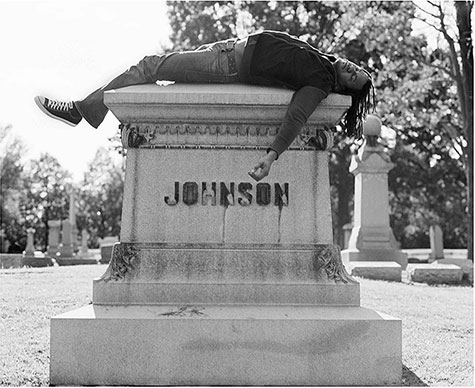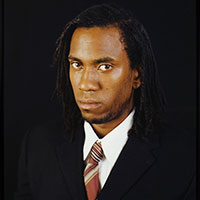
A young man in suit and tie gazes warily at the camera, taking its measure, betraying nothing, sly wit reserved for the title. In Self Portrait with My Hair Parted Like Frederick Douglass (2003), Rashid Johnson pays homage to the 19th-century abolitionist, putting himself in dialogue with this renowned cultural icon but also crafting his own myth of artistic self-creation.

This fall, the Mildred Lane Kemper Art Museum will present Rashid Johnson: Message to Our Folks, the first major solo museum exhibition to survey the career of the Chicago-born, New York-based artist. In works that span photography, painting, sculpture and video, Johnson confronts old assumptions about the African-American experience while exploring, often playfully, the complexities, contradictions and singular histories that comprise black identity today.
Though Johnson frequently alludes to historical and cultural figures, he also incorporates commonplace objects from his own childhood, a process he describes as “hijacking the domestic.” Plants, books, record albums, photographs, soap — all become the working materials for conceptually loaded and visually compelling artworks.
Death by Black Hole “The Crisis” (2010) includes books by astrophysicist Neil deGrasse Tyson and social critic Harold Cruse, while Triple Consciousness (2009) serves as a virtual altar to Al Green’s 1975 Greatest Hits. In The Shuttle (2011), Johnson layers references to comedian (and one-time presidential candidate) Dick Gregory and his own father. Self Portrait Laying on Jack Johnson’s Grave (2006) juxtaposes the historical and contemporary, depicting the artist collapsed across the heavyweight champion’s gravestone.
Johnson’s work remains grounded in the strategies of modern and contemporary art, particularly abstraction and appropriation. Antibiotic (2011) is a large, aggressively textured painting executed in black soap and wax, while Promised Land and Run (both 2008) consist of their respective titles spray-painted, graffiti-style, onto mirrors. In Black Steel in the Hour of Chaos (2008), Johnson scales a marksman’s viewfinder to darkly comic proportions, leaving viewers to determine on which side of the crosshairs they stand.
Johnson’s frequent use of shea butter, derived from the African shea tree, obliquely recalls Joseph Beuys’ use of animal fats but also alludes to the lapsed Afrocentrism of his parents, humorously questioning the application of “Africanism” to one’s body. A similar note is struck by The Unwearable Dashiki (2001), created by exposing scattered chicken bones to a photo-sensitive sheet. Conversely, Johnson’s series The New Negro Escapist Social and Athletic Club “documents” an invented secret society of black intellectuals, combining 1920s-style portraiture — reminiscent of Harlem Renaissance photographer James Van Der Zee — with the cosmic, metaphysical questing of Afrofuturists like Sun Ra.
Rashid Johnson: Message to Our Folks is organized by curator Julie Rodrigues Widholm from the Museum of Contemporary Art Chicago, where it debuted in 2012. The St. Louis exhibition is curated by Meredith Malone, associate curator at the Kemper Art Museum. The exhibition also has traveled to the Miami Art Museum (fall 2012) and the High Museum of Art, Atlanta (summer 2013).
About the artist
Born in Chicago in 1977, Johnson earned a bachelor’s degree in fine arts from Columbia College Chicago in 2000 and attended the MFA program at the School of the Art Institute of Chicago in 2003. He moved to New York in 2005, where he currently lives and works.
Johnson has exhibited widely in both the United States and Europe. Recent solo exhibitions include New Growth, Ballroom Marfa, Texas (2013); Smoke and Mirrors, Sculpture Center, New York (2009); Sharpening My Oyster Knife, Kunstmuseum Magdeburg, Germany (2008); and The Production of Escapism, Indianapolis Museum of Contemporary Art (2005).
Major group exhibitions include the 9th Shanghai Biennale, Reactivation, China (2012) and the 54th Venice Biennale, ILLUMInations, Italy (2011).
Exhibition catalog
A fully illustrated catalog — the most comprehensive documentation of Johnson’s work to date — accompanies the exhibition. Contributors include Rodrigues Widholm, art historian Ian Bourland and novelist and critic Touré. The book also features an excerpt from Paul Beatty’s trenchant and comic coming-of-age novel The White Boy Shuffle (1996).
Exhibition and support
Rashid Johnson: Message to Our Folks will open with a public reception 7-9 p.m. Friday, Sept. 20, and will remain on view through Jan. 6, 2014. Both the reception and the exhibition are free and open to the public.
The Kemper Art Museum is located on Washington University’s Danforth Campus, immediately adjacent to Steinberg Hall, near the intersection of Skinker and Forsyth boulevards. Regular hours are 11 a.m. to 6 p.m. Mondays, Wednesdays and Thursdays; 11 a.m. to 8 p.m. Fridays; and 11 a.m. to 6 p.m. Saturdays and Sundays. The museum is closed Tuesdays.
Support for Rashid Johnson: Message to Our Folks at the Mildred Lane Kemper Art Museum is provided by James M. Kemper Jr.; the David Woods Kemper Memorial Foundation; the William T. Kemper Foundation; the Hortense Lewin Art Fund; the Missouri Arts Council, a state agency; the Regional Arts Commission; Washington University’s Office of the Provost; and members of the Kemper Art Museum.
For more information, call (314) 935-4523 or visit kemperartmuseum.wustl.edu.